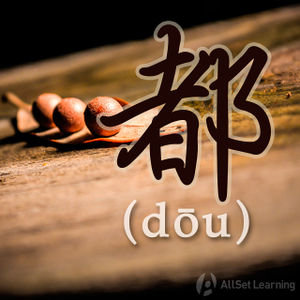Difference between revisions of "Expressing "every time" with "mei" and "dou""
m (Text replace - "{{Grammar Box}} " to "{{Grammar Box}} ") |
|||
| Line 1: | Line 1: | ||
{{Grammar Box}} | {{Grammar Box}} | ||
| − | " | + | "每……都……" (měi... dōu...) is a pattern used to express "every" when talking about a quantitative amount. This is similar to how we say "every day I eat cereal" or "every student passed the exam." |
| − | == Using | + | == Using 每……都…… to mean "every" == |
Using 每 and 都 together is pretty simple. | Using 每 and 都 together is pretty simple. | ||
| Line 9: | Line 9: | ||
<div class="jiegou"> | <div class="jiegou"> | ||
| − | 每 | + | 每 + Measure Word + Noun + 都 + Adjective/Verb |
</div> | </div> | ||
| − | Note | + | Note that technically you can put a number before the measure word, but it's almost always just "one", and then it's usually omitted. |
=== Examples === | === Examples === | ||
| Line 19: | Line 19: | ||
<div class="liju"> | <div class="liju"> | ||
| − | *我 <em>每</em> | + | *我 <em>每</em> 个 星期 三<em> 都</em> 去 实习。<span class="trans">I go to my internship every Wednesday.</span> |
| − | *他 <em>每</em> | + | *他 <em>每</em> 天 <em>都</em> 上 班。<span class="trans">He works every day.</span> |
*我姐姐 <em>每</em>天 <em>都</em>要 弹 一小时 钢琴 。<span class="trans">My old sister has to play the piano for one hour everyday.</span> | *我姐姐 <em>每</em>天 <em>都</em>要 弹 一小时 钢琴 。<span class="trans">My old sister has to play the piano for one hour everyday.</span> | ||
*我 <em>每</em> 天 <em>都</em> 学 两 个 小时 的 中 文。<span class="trans">I study chinese for two hours everyday.</span> | *我 <em>每</em> 天 <em>都</em> 学 两 个 小时 的 中 文。<span class="trans">I study chinese for two hours everyday.</span> | ||
| Line 48: | Line 48: | ||
==See also== | ==See also== | ||
| + | |||
*[[Pronoun "mei" for "every"]] | *[[Pronoun "mei" for "every"]] | ||
*[[Emphasising quantity with "dou"]] | *[[Emphasising quantity with "dou"]] | ||
Revision as of 14:35, 18 June 2014
-
Level
-
Similar to
-
Used for
-
Keywords
"每……都……" (měi... dōu...) is a pattern used to express "every" when talking about a quantitative amount. This is similar to how we say "every day I eat cereal" or "every student passed the exam."
Contents
Using 每……都…… to mean "every"
Using 每 and 都 together is pretty simple.
每 + Measure Word + Noun + 都 + Adjective/Verb
Note that technically you can put a number before the measure word, but it's almost always just "one", and then it's usually omitted.
Examples
- 我 每 个 星期 三 都 去 实习。I go to my internship every Wednesday.
- 他 每 天 都 上 班。He works every day.
- 我姐姐 每天 都要 弹 一小时 钢琴 。My old sister has to play the piano for one hour everyday.
- 我 每 天 都 学 两 个 小时 的 中 文。I study chinese for two hours everyday.
Just make sure that when you went to express "every one" with 每, as in "every day I take a nap", don't forget the 都! Sometimes you don't necessarily need it, but when in doubt, just use it to be safe! 都 can also be used to say "both" if there are only two things being referenced. It's possible to think of this as being "all two" of something, even if that sounds somewhat weird in English. It's just how Chinese says "both", by using the same word that it uses for other, larger numbers as well.
Using 每 and 都 when focusing on a certain action
In this grammar structure, we focus on every time a certain action is done, like "every time he speaks I can't understand him."
每 +Verb + Number+ 都 + Adjective/Verb
Examples
- 他 每 说 一 句 话,我 都 不 明白。every time he speaks I can't understand him.
- 她 每 参观一个 地方 都 要 拍照。Every time she visits some place, she takes photos.
- 我 每 看完 一部电影 都 想 跟 他讨论。Every time I finish watching a movie, I want to discuss it with him.
- 记住,每 写完一 篇 文章 都 要 保存。Remember, every time you finish an article, save it.
See also
Sources and further reading
Books
- Chinese: An Essential Grammar, Second Edition (pp. 87-8) →buy
- Integrated Chinese: Level 1, Part 1 (3rd ed) (pp. 267) →buy
- Modern Mandarin Chinese Grammar: A Practical Guide (pp. 284-5) →buy



